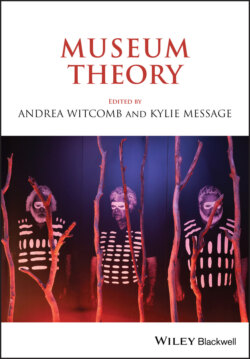Читать книгу Museum Theory - Группа авторов - Страница 41
3
WHAT, OR WHERE, IS THE (MUSEUM) OBJECT?
Colonial Encounters in Displayed Worlds of Things
ОглавлениеSandra H. Dudley
This chapter reflects on the dynamics of the moments, however brief, in which museum visitors stop to look closely at things on display. It explores some ways in which we might conceptualize what is distinctive about those moments, especially with a view to beginning a new consideration of the ontological and methodological position and potential of the museum and its collections in the twenty-first century. Nicholas Thomas has posited “the museum as method,” suggesting that it is time to move beyond concerns around representation as an analytical and practical starting point and proposing instead beginning with critical reflection on the implications of the “routine aspects of curatorial work, such as captioning objects and juxtaposing them in displays” for exhibitionary practice (2010, 6). Thomas’s proposition is centered on anthropological museums but has ramifications for the technology and praxis of museums more broadly. Also taking a stance honed in the anthropological museum, I too am seeking to move away from a central or initial focus on representation. My primary concern in this chapter, however, is not – explicitly at least – the museum’s methods, but the moments of encounter between things on display and museum visitors, and ways in which they might be envisaged and described. Most especially, this is an initial attempt to explore ways in which those encounters might be imagined from the object’s point of view, and to consider what might be some of the implications of doing so.
The chapter emphasizes the encounter between visitor and thing. What is in question are those moments when the visitor stops to really consider something that particularly catches the eye or especially intrigues or appalls; I am less interested in the more general perambulatory drift through galleries and the brief glimpses visitors may throw at the sometimes seemingly vast populations of objects and labels they pass by, though that is an important part of the context. Indeed, the “perambulatory drift” through the gallery is in reality more than contextual, although it is not my main focus here. Elkins, for example, writes of a walk through a grocery store:
I think that in the most evanescent way possible – a way so ineffable that the word “ineffable” is too coarse to describe it – I am aware of every single object in the store, which is to say I react differently to the presence of every object. Sometimes I return their gaze and even decide to buy them … More often I am scarcely aware of them – the entire aisle of health foods goes by in a flash and doesn’t even enter my consciousness – but my actions are ways of defining myself, and I have a particular reaction to each one. (1996, 73)
I position the moment of encounter on which I focus in this chapter, as a dynamic process in which both participants, person and thing, are active and significant. The chapter does not center on the technology, power, and role of the museum itself; the implication is not that the institution’s part is insubstantial (clearly it is not), but the aim is rather to shift attention to what happens between persons and things on a more micro scale. Throughout, the chapter draws on and develops other themes, in particular that of colonial encounters, as a metaphor through which both to visualize museum encounters and to begin to conceptualize them from the perspective of displayed things.
The attempt to take the artifact’s point of view will be problematic for many readers: surely museum objects – no more than scallops (see Callon 1986) – cannot have the subjectivity this seems to imply? Yet, as a thought experiment at least, I hope to show its value in demonstrating the flexibility and challenging potential of things in the museum. I consider it more than simply a rhetorical device or trick, however; instead, it is what the great Romantic biographer Richard Holmes, writing of subject-centered, visual and material biographical techniques, has called a “reversal of perspective, looking outwards from within … rather than the more usual attempt to look inwards from the outside … turning the viewpoint inside out, if only for a moment” ([1985] 2005, 178; emphasis original). In the setting of material objects, I propose, first, that this methodological volte-face, even if only fleeting, may be one way to consider what Brown calls the thingness of objects,1 which is what we confront “when they stop working for us: when the drill breaks, when the car stalls, when the windows get filthy” (2001, 4), and disable our usual “smooth coping” (Wheeler 2005, 129), and, arguably, operates in a special way in the museum where objects can no longer function as they were designed and/or we would ordinarily expect. Second, it is a procedural route toward a renewed thing centeredness in amended display and interpretive strategies that recognize people and objects alike are part of a mutually interdependent, material world, full of multiple and shifting meanings, values, and functions.
